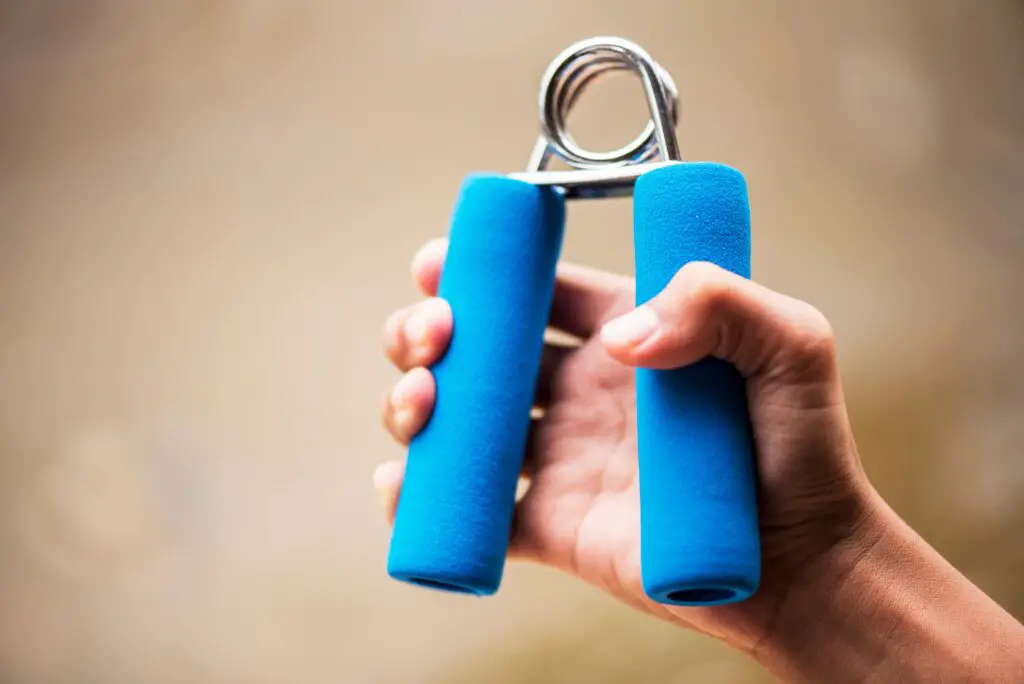Introduction
How To Use Grip Strength Trainer: The world of enhanced hand strength and dexterity! If you’re seeking a comprehensive guide on how to effectively use a grip strength trainer, you’ve come to the right place. Whether you’re an athlete looking to improve your performance, a musician aiming for greater finger agility, or simply someone who wants to enhance their everyday grip, this guide will walk you through the ins and outs of maximizing the benefits of a grip strength trainer. From understanding the different types of grip traditional strength and their importance in various activities, to learning a range of exercises tailored to your goals, this guide will empower you to develop a strong and versatile grip. So, let’s dive in and unlock the potential of your hands with the knowledge and techniques to make the most out of your grip strength trainer. Welcome to the world of enhanced hand strength and dexterity! In a society where many aspects of our lives involve digital interfaces and passive activities, the importance of maintaining strong and functional grip strength often goes overlooked.
Whether you’re an avid rock climber, a dedicated weightlifter, a passionate musician, or simply someone who recognizes the significance of a firm handshake, a grip strength trainer can be a game-changer in your journey towards improved hand strength and overall physical performance. This guide is designed to be your compass in navigating the realm of grip strength training. We will embark on a comprehensive journey, covering everything from the fundamental principles of grip strength, the different types of grip and their applications, to a wide array of exercises that cater to your specific goals. Whether you’re rehabilitating a hand injury, seeking to enhance your athletic prowess, or even aiming to mitigate the challenges of conditions like arthritis, this guide will provide you with the insights and techniques necessary to make the most out of your grip strength trainer.
As we delve into the various aspects of grip strength training, you’ll gain a deeper understanding of how the hand muscles work in tandem, the importance of grip strength in daily activities and specialized pursuits, and the science behind progressive resistance training. Armed with this knowledge, you’ll be equipped to craft a personalized grip strength training regimen that aligns with your aspirations and targets the areas you wish to improve. So, if you’re ready to unlock the potential of your hands and embark on a journey towards greater strength, control, and versatility, let’s dive into the world of grip strength training and discover how this often underestimated aspect of fitness can contribute to your overall well-being and success.

How long should I use a grip strength trainer?
Hand Grippers are best used in sets and reps, an example of this is 5 sets of 10 reps with around 30 seconds/1 minute between sets. Do this a couple of times a day for a week or so, then you will start seeing the results.
Starting Point: If you’re new to grip strength training, it’s advisable to start gradually. Begin with shorter sessions to allow your hand muscles and tendons to adapt to the new stress. Aim for 10-15 minute sessions a few times a week.
Progression: As your hands become accustomed to the training, gradually increase the duration and intensity. You can extend your sessions to 20-30 minutes as you become more comfortable. However, avoid overexerting yourself, as overtraining can lead to injuries.
Frequency: Consistency is key. Depending on your goals, training 2-4 times a week is generally effective. This frequency provides adequate time for recovery while allowing you to challenge your grip strength regularly.
Intensity: The intensity of your grip strength training matters. If you’re performing high-intensity exercises, shorter sessions might be appropriate to avoid excessive strain. On the other hand, if you’re using lower resistance levels or focusing on endurance, longer sessions can be more suitable.
Can I use grip trainer everyday?
Hand grips are used for training or preparing your hand muscles for the exercise sessions. Though they can be used every day, it is important to use them for the right duration and with the right resistance level. Check with your fitness trainer before incorporating these hand grips into your exercise routine.
Balanced Approach
If you choose to train daily, alternate between high-intensity and low-intensity sessions. For example, focus on lighter, endurance-based exercises on some days, and higher-resistance exercises on others.
Pay close attention to how your hands feel. If you notice signs of fatigue, soreness, or strain, it’s essential to adjust your training frequency or intensity accordingly.
Incorporate rest days between your grip training sessions to allow your hand muscles time to recover and grow.
Considerations and Risks
Training your grip muscles every day without sufficient recovery can lead to overtraining. Over time, this may result in decreased performance, increased risk of injury, and burnout.
Continuous strain on your hand muscles can lead to muscle fatigue and decreased grip strength, hindering your progress.
Using high resistance levels or training intensely every day can increase the risk of hand and wrist injuries, such as strains, sprains, or even tendonitis. Your muscles grow during recovery, not during training. Without adequate rest, your muscles won’t have the chance to repair and strengthen, potentially hindering your gains.
Is it OK to use hand grippers everyday?
To build hand strength and muscle mass, you should use hand grips for at least 24 hours for two weeks. You need to use hand grips at least 2 hours a day in a day. You should use the hand grips regularly for at least six months to see visible changes.
Balanced Approach
If you opt for daily hand gripper use, alternate between different resistance levels and intensity levels. This can prevent overexertion and reduce the risk of overtraining.
Pay close attention to how your hands feel. If you experience persistent discomfort, soreness, or signs of strain, adjust your training frequency or intensity.
Incorporate rest days into your routine to allow your hand muscles ample time for recovery and growth.
Consider implementing a periodized approach, cycling between phases of intense training and recovery to prevent overtraining.
Consult a Professional
If you’re unsure about the appropriate frequency for using hand grippers, it’s wise to consult a fitness professional, physical therapist, or healthcare provider. They can evaluate your individual needs, goals, and physical condition to provide tailored advice. Strive for a balance between training frequency, intensity, and recovery. By doing so, you can reap the advantages of grip training while safeguarding against potential risks and optimizing your progress. Always prioritize hand health and listen to your body’s signals to ensure a sustainable and effective training routine.
Do grippers increase forearm size?
Grippers are a great way to build your forearm size and strength and offer a unique stimulus compared to other exercises. Lifters should look to use a full range of motion with maximal force and incorporate varying protocols such as drop sets, eccentrics, and isometrics.
Grippers primarily target the muscles responsible for hand closing, such as the flexor muscles of the fingers and wrists. While these muscles are located in the forearm, they are relatively small compared to the larger muscles like the flexor carpi radialis and brachioradialis. Therefore, while grippers can certainly contribute to forearm development, they may not be the sole or most efficient method for significant forearm size gains.
For substantial forearm size increase, it’s crucial to incorporate a well-rounded approach that targets all major muscle groups in the forearm. This includes exercises that work on both flexion (closing grip) and extension (opening grip) motions, as well as wrist rotation exercises.
Like any muscle group, allowing adequate recovery time is essential for growth. Overtraining can hinder progress. Aim for 2-3 forearm training sessions per week, allowing 48 hours between sessions.
To support muscle growth, ensure you’re providing your body with adequate nutrition and enough restorative sleep. Protein intake is especially important for muscle repair and growth.
Do grip trainers burn calories?
All physical exercise burns some calories, as your body is using energy to perform an action. However, grip trainers only activate some of the smallest muscles in your body, which means the calorie burn isn’t as great as it would be with cardio exercises, or when working out larger muscle groups.
Role in Overall Calorie Expenditure
Grip training alone may not be the most efficient way to burn calories when compared to activities like running, cycling, or aerobics. However, grip training can be integrated into a well-rounded fitness routine to enhance overall calorie burn:
Combined Workouts: Incorporating grip training exercises into circuit-style or interval workouts that include full-body movements can increase calorie burn while benefiting grip strength.
Active Recovery: Light grip training can be used during rest days or active recovery sessions to keep your body moving and expend some calories without intense strain.
Metabolic Boost: Engaging your muscles through grip training can have a small, positive impact on your metabolic rate, leading to additional calorie burn over time.
Do hand grippers build forearms?
Your forearm flexors and extensors are the muscles which control the opening and closing of your fingers. These are the main muscles working when using hand grips, so if you’re looking to build muscular looking forearms, as well as a mighty strong grip, hand grips are definitely a good choice for you.
How Hand Grippers Work
Hand grippers primarily target the flexor muscles of the fingers and wrists. These muscles are located in the forearm and are responsible for gripping and closing your hand. When you squeeze a hand gripper, these muscles contract, creating resistance that you must overcome.
Forearm Development with Hand Grippers
While hand grippers can indeed stimulate the muscles in your forearm, they may not be the most efficient way to achieve substantial forearm size gains. The muscles targeted by grippers, while important, are relatively small compared to other muscles in the forearm.
Balancing Hand Gripper Use
Integrating hand grippers into your forearm training regimen can be effective, but they should be one component of a comprehensive approach. To effectively build forearm size and strength.
Can I train forearms everyday?
Forearms are much like calves and abs, too: They’re a muscle group that should get routine work almost every day. That means you don’t need to take a “rest” day from training forearms.
Potential Risks and Considerations
Overtraining: Training your forearms intensely every day without adequate recovery can lead to overtraining. Over time, this can result in decreased performance, injury, and burnout.
Muscle Fatigue: Continuous strain without sufficient recovery can lead to muscle fatigue, hampering your grip strength and overall forearm training progress.
Injury Risk: Overuse injuries, strains, and sprains are more likely when you train your forearms daily, especially if you’re using heavy resistance or improper form.
Diminished Gains: Muscles grow during recovery, not during training. Insufficient recovery time can limit muscle growth and strength gains.
What is the purpose of a grip trainer?
Just as you would use weights or machines for resistance to strengthen large muscles of the body, such as the glutes and lats, grip strengtheners provide resistance to strengthen the smaller muscles of the hands. Research has found that, over time, increases in grip strength can carry over to sport performance.
Enhanced Grip Strength
The primary purpose of a grip trainer is to develop and strengthen the muscles responsible for gripping and holding objects. By providing resistance against hand closure, grip trainers challenge the flexor muscles of the fingers and wrists. This increased resistance leads to muscle adaptation, growth, and improved grip strength over time.
Comprehensive Forearm Development
Grip trainers target specific forearm muscles, contributing to a well-rounded forearm development routine. While not the only exercise needed for complete forearm strength, they play a crucial role in targeting the muscles involved in hand closing.
Athletic Performance
Athletes in various sports benefit from grip trainers to enhance their performance. Climbers, weightlifters, martial artists, golfers, and tennis players, among others, rely on strong grip strength for optimal performance. A powerful grip improves control, accuracy, and overall athletic prowess.

Conclusion
In a society where the importance of hand strength often remains overshadowed, you now possess the knowledge and tools to cultivate a grip that can transform your physical abilities and enhance your daily experiences. Throughout this journey, we’ve explored the intricacies of grip strength, ranging from its foundational principles to advanced techniques. We’ve delved into the diverse types of grip, understanding their applications across various domains. Moreover, we’ve navigated through a spectrum of exercises, each tailored to target specific areas of improvement. Armed with the insights gained, you’re now equipped to embark on a personalized grip strength training journey. By incorporating the science of progressive resistance and understanding the interplay of hand muscles, you can sculpt a grip that not only meets your goals but also brings new dimensions to your pursuits – be it in sports, music, or daily tasks.
Remember, the benefits of grip strength training transcend the physical realm. The discipline, commitment, and resilience you apply to your training can extend to other aspects of your life, shaping your mindset and fortifying your determination. So, whether you’re an athlete striving for peak performance, an individual seeking relief from hand-related challenges, or someone simply aiming to elevate your quality of life, the grip strength trainer is your ally. With dedication, patience, and the insights gained from this guide, you’re poised to unlock the incredible potential within your grasp. Embrace the journey, relish the progress, and celebrate the strength you’ll develop – not just in your hands, but in your character as well. This guide has led us from the foundations of grip strength, through the exploration of various grip types and their real-world applications, and finally to a diverse repertoire of exercises that cater to every individual’s unique goals. But beyond the physical techniques, we’ve also touched upon the psychological elements of discipline, determination, and the sense of accomplishment that accompanies progress. Armed with the knowledge acquired, you’re now empowered to embark on a personal journey of growth.
Through consistent practice, the utilization of progressive resistance, and an understanding of the mechanics of grip, you can sculpt hands that not only perform better but also enrich your life – from excelling in your favorite sports to effortlessly tackling everyday tasks. This journey is a testament to your commitment to self-improvement, one that extends beyond the boundaries of grip strength alone. As you continue refining your grip, remember that the skills you cultivate and the mindset you nurture can influence various aspects of your life, creating a ripple effect of resilience and perseverance. In essence, the grip strength trainer is not just a piece of equipment; it’s a gateway to unlocking your potential. Embrace the challenges, savor the victories, and relish the evolution of your grip and character alike.

